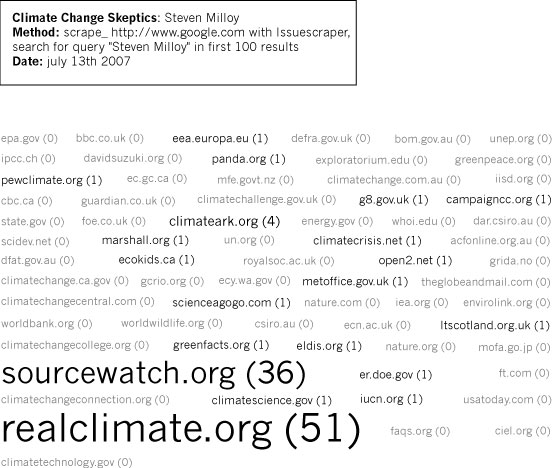Tactics
Issue Mapping tactics are modular guidelines that can be used in the context of different research strategies in issue mapping. These tactics focus on questions and concerns that are specific to issue mapping online and may be combined with other methods and approaches. Each in different ways, the tactics are designed to deploy features of online information and devices – such as hyperlinking and tag cloud visualisation – for purposes of issue mapping. Alluding to key questions of issue mapping, such as “What is an issue?” or “How timely or active is the issue?”, the tactics also provide ways to translate these questions into inventive visual outputs and to demonstrate their relevance for various social and activist contexts.
 |
Detecting Actor Partisanship
To detect actor partisanship is to identify the leaning of actors involved in an issue. This tactic was developed as an application of the Google Scraper, which can be used to determine the strength of associations between actors and issues. Relying on indicators of ‘known bias’, this tactic asks: How prominent are partisan actors – such as ‘climate skeptics – in a particular issue space? Or: how prominent are partisan terms – such as ‘efficiency’ – in a particular actor network? |
Climate Change ScepticsConflict analysis of the usage, in official and unofficial sources, of ‘security fence’ and ‘apartheid wall’… |
 |
Issue Profiling
This tactic focuses on the identification of the key elements that compose an issue, such as specific issue terms, actors and action formats. Issue profiling can take different forms: it can focus on breaking down an issue into composite terms, by determining the prominence of different issue terms in a given issue space. Or it can compare the behaviour of one issue term accross different spheres or spaces. Issue profiling provides a way to examine issue specificity, as well as changes in issue composition over time. |
Sustainable homesOld Controversies Now |
 |
Mapping Issue Resonance
This tactic uses Google Scrapers to determine the relative and comperative currency of particular issue terms across social, organisational and media spheres. Using word frequency analysis, the analysis of issue resonance can serve at least two ends: to identify the resonance of particular issue terms in a wider issue space; or to determine the features of specific media spheres or platforms through their treatment of issues. In the latter case, issue resonance is measured for an entirely platform or medium (web, blogs, wikipedia). |
Issue AnimalsCross-spherical content analysisWhat is the problem with smart meters? |
 |
Liveness and Liveliness
This tactic focuses on establishing the difference between issue dynamics: between the hotness of an issue and its eventfulness over time. Some issues have strong liveness: they achieve high currency during a set period of time. Others are lively: these issues are active in that their composition fluctuates over time. This tactic is concerned with the happening of issues and its relation to time, as well as inventive ways to visualise them. |
Pace OnlineOld Controversies NowAusterity and Crisis on Twitter and GoogleIssue Lifelines: Climate Change on Twitter |
 |
Issue Action Formats
This tactic explores the action formats specific to issues on a range of platforms and devices. Identifying issue actions is part of issue profiling, but also allows investigation of the dynamism of an issue. |
Do formats organize networks?Distributed Activism on Facebook |
| Issue Partisanship
Different from actor partisanship, this tactic is concerned with determining the leaning of the issue and its overall normative bias. |
Political SearchDetecting the Bias of Issues with Twitter |
